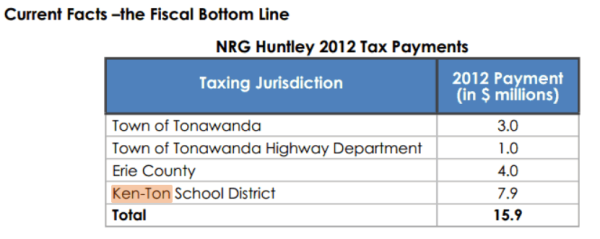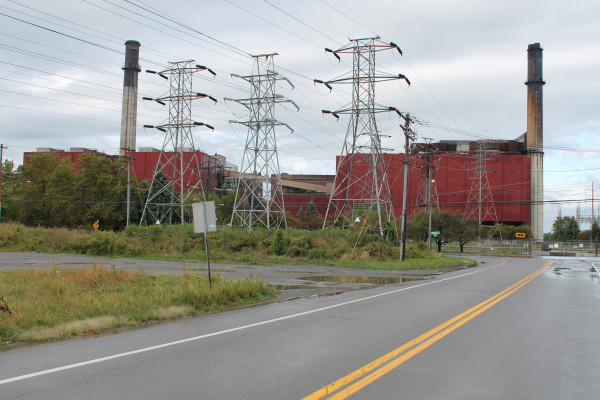Jan 28
2014
NRG Huntley plant belching red ink

NRG’s coal plant in the Town of Tonawanda is losing an average of $1 million a year and is at risk of closing, according to a new report.
The report by the Institute for Energy Economics and Financial Analysis provides a warning to Huntley employees, community residents, the Ken-Ton school district and elected leaders: prepare now for the plant’s closing.
The warning is based on the financial stress that such a closure would create for the community: 70 lost jobs and $16 million less tax revenue, half of which goes to the Ken-Ton school system. The Buffalo News reports that town officials said the analysis uses old tax revenue data and that revenue losses would be less than half of what is shown in the graphic below because of a renegotiated payment in lieu of taxes agreement.
Investigative Post reported last year that all three of this region’s coal plants are struggling because of low natural gas prices and high coal prices. NRG also owns the coal plant in Dunkirk, for which regulators recently approved plans to convert to natural gas.
The IEEFA report concludes:
“The future for the Huntley plant does not indicate any near-term relief from the economic forces that have made the plant unprofitable in recent years.”
The Huntley plant has been operating since 1942. Four of its six coal-burning units have been retired.
Huntley’s financial woes can be traced back to 2008’s recession, when demand for electricity dropped.
But the problems stretch beyond decreased demand.
The report explains that natural gas prices have dropped 60 percent since 2008, while the price to deliver coal increased nearly 7 percent each year over the past decade.
In turn, coal plants are not operating anywhere near capacity. In 2012, Huntley operated at one- fifth of its generating capacity and lost $3 million.
And although natural gas prices are beginning to rise, which will result in a boost to coal’s share of the market, none of this is likely to be enough to keep the plant running for long, the report states.
To add insult to injury, all three of Western New York’s coal plants are among the worst greenhouse gas polluters in this state, including the top spot that goes to the Somerset plant in Niagara County, which went into bankruptcy and is now owned by a group of bondholders.
NRG’s CEO David Crane is well aware of these problems, and even hinted in August at closing the energy company’s 16 coal-fired power plants. The company has increased its investments in solar energy that will create thousands of new jobs.
Crane told Bloomberg:
“Natural gas is already wiping out coal, and it’s going to wipe out most nuclear. “There will be only a handful of nukes that we’ll need to keep running as base load plants.”
The Huntley plant’s viability could hinge on producing electricity when demand is high in the summer and winter months, and for baseload power that is needed throughout the day, according to some experts.
Lincoln F. Pratson, the Semans-Brown Professor of Earth and Ocean Science at Duke’s Nicholas School of the Environment, told Investigative Post in July: “I know there are people who would love to see coal go away, but current needs for baseload power are going to keep a significant fraction of coal plants online for awhile. They are the kind of work horses that have been used to provide the power that is needed at all times of the day.”
The report states that New York has excess capacity, so retiring the Huntley plant would not create any capacity deficiency. But it could require upgrades to transmission lines that deliver electricity—an issue that delayed NRG’s plans to convert its Dunkirk plant to natural gas.
David Gaier, an NRG spokesman, said in an email today that he cannot confirm any of the information in the report and that the organization never contacted the company for information or comment. He noted that the Ohio-based organization’s mission is to reduce dependence on coal and other non-renewable energy resources, “and this report appears written to support that mission.”
He said NRG spent $35 million in 2005 at Huntley so the plant could use low sulfur coal, which produces less pollution. The Huntley plant also earned $110 million that year, according to the report. Four years later, the company spent $115 million to install environmental controls that reduce mercury, nitrogen oxides and sulfur dioxide, he said.
Nonetheless, Gaier agreed that coal plants everywhere are under significant financial pressure.
“Having said that, we believe that there is an appropriate role for coal plants with proper environmental controls to contribute to the nation’s energy supply – for example, diversity of fuel supply has been crucial to ensuring reliable operations of the power grid during two cold-weather events already in January,” he said.
Environmentalists have already jumped on the report’s findings.
“As this report shows, we can no longer afford the price of dirty power, the impacts it has on our environment, or the destruction it has caused to our health,” said Peter Iwanowicz, executive director of Environmental Advocates of New York.
“Retiring this plant is in the best interest of ratepayers and it will provide a great needed breath of fresh air for those living near the plant.”
The Clean Air Coalition of Western New York requested the IEEFA to produce the report.
“There isn’t a viable future for this facility as a coal plant,” said Erin Heaney, executive director of the Coalition. “We feel that it’s time for everyone to come to the table to protect workers’ jobs, preserve the environment and generate sufficient tax revenue for the region.”
The Clean Air Coalition will host a series of community meetings to share the report and discuss options to help the community prepare in case the plant closes:
- Saturday, March 1 at 3 p.m. Boys and Girls Club 43 Riverdale Road, Town of Tonawanda
- Thursday, March 6 at 6 p.m. Northwest Community Center, 155 Lawn Ave in Riverside
- Wednesday, March 13 at 6 p.m. City of Tonawanda City Hall, 200 Niagara Street
- A meeting in Grand Island is to be determined.
Read Investigative Post’s transparency policy on coverage related to the Clean Air Coalition.


